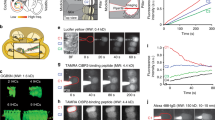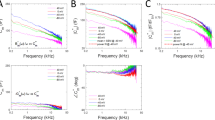Abstract
An important function of the peripheral auditory system is the resolution of complex sounds into their constituent frequency components. It is well established that each mechanoreceptive hair cell of the cochlea is maximally sensitive to a particular frequency of sound1,2, but the mechanisms by which this sharp frequency selectivity is achieved are still controversial3. The complex mechanical and hydrodynamic properties of the receptor organs and of the hair cells themselves are certainly involved3. However, in at least one auditory organ, the turtle cochlea, frequency tuning is greatly enhanced by the electrical properties of the hair-cell membrane; each cell in this organ behaves as an electrical resonator tuned to a narrow band of frequencies4. Using the ‘Gigaseal’, whole-cell recording technique5, we have investigated the biophysical basis of similar resonant behaviour in enzymatically isolated hair cells from the bullfrog sacculus. We report here the identification of three voltage- and ion-dependent conductances which may contribute to the electrical tuning mechanism: a non-inactivating calcium conductance, an A-type K+ conductance, and a Ca2+ -activated K+ conductance6.
This is a preview of subscription content, access via your institution
Access options
Subscribe to this journal
Receive 51 print issues and online access
$199.00 per year
only $3.90 per issue
Buy this article
- Purchase on Springer Link
- Instant access to full article PDF
Prices may be subject to local taxes which are calculated during checkout
Similar content being viewed by others
References
Russell, I. J. & Sellick, P. M. J. Physiol., Lond. 284, 261–290 (1978).
Dallos, P., Santos-Sacchi, J. & Flock, A. Science 218, 582–584 (1982).
Dallos, P. A. Rev. Phychol. 32, 153–190 (1981).
Crawford, A. C. & Fettiplace, R. J. Physiol., Lond. 312, 377–412 (1981).
Hamill, O. P., Marty, A., Neher, E., Sakmann, B. & Sigworth, F. J. Pflügers Arch. ges. Physiol. 391, 85–100 (1981).
Lewis, R. S. Soc. Neurosci. Abstr. 8, 728 (1982).
Hagiwara, S. & Byerly, L. A. Rev. Neurosci. 4, 69–125 (1981).
Hodgkin, A. L. & Huxley, A. F. J. Physiol., Lond. 117, 500–544 (1952).
Eckert, R. & Tillotson, D. L. J. Physiol., Lond. 314, 265–280 (1981).
Connor, J. A. & Stevens, C. F. J. Physiol., Lond. 213, 21–30 (1971).
Neher, E. J. gen. Physiol. 58, 36–53 (1971).
Thompson, S. H. J. Physiol., Lond. 265, 465–488 (1977).
Thompson, S. J. gen. Physiol. 80, 1–18 (1982).
Meech, R. W. A. Rev. Biophys. Bioengng 7, 1–18 (1978).
Furukawa, T. & Matsuura, S. J. Physiol., Lond. 276, 193–209 (1978).
Sand, O., Ozawa, S. & Hagiwara, S. J. comp. Physiol. 102, 13–26 (1975).
Corey, D. P. & Hudspeth, A. J. Nature 281, 675–677 (1979).
Crawford, A. C. & Fettiplace, R. J. Physiol., Lond. 315, 317–338 (1981).
Art, J. J., Crawford, A. C., Fettiplace, R. & Fuchs, P. A. Proc. R. Soc. B216, 377–384 (1982).
Mauro, A., Conti, F., Dodge, F. & Schor, R. J. gen. Physiol. 55, 497–523 (1970).
Morris, C. & Lecar, H. Biophys. J. 35, 193–213 (1981).
Plant, R. E. Biophys. J. 21, 217–237 (1978).
Adams, P. R., Constanti, A., Brown, D. A. & Clark, R. B. Nature 296, 746–749 (1982).
Yellen, G. Nature 296, 357–359 (1982).
Author information
Authors and Affiliations
Rights and permissions
About this article
Cite this article
Lewis, R., Hudspeth, A. Voltage- and ion-dependent conductances in solitary vertebrate hair cells. Nature 304, 538–541 (1983). https://doi.org/10.1038/304538a0
Received:
Accepted:
Issue Date:
DOI: https://doi.org/10.1038/304538a0
This article is cited by
-
Human Sensation of Transcranial Electric Stimulation
Scientific Reports (2019)
-
Molecular basis of ancestral vertebrate electroreception
Nature (2017)
-
Seasonal plasticity of auditory saccular sensitivity in “sneaker” type II male plainfin midshipman fish, Porichthys notatus
Journal of Comparative Physiology A (2017)
-
Hair cell force generation does not amplify or tune vibrations within the chicken basilar papilla
Nature Communications (2016)
-
Relating structure and function of inner hair cell ribbon synapses
Cell and Tissue Research (2015)
Comments
By submitting a comment you agree to abide by our Terms and Community Guidelines. If you find something abusive or that does not comply with our terms or guidelines please flag it as inappropriate.



